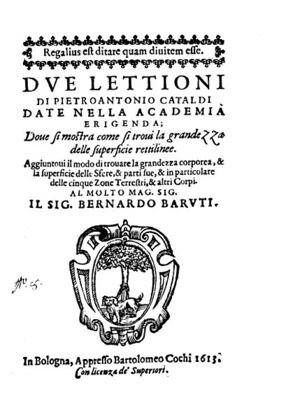Pietro Cataldi (nonfiction)
Pietro Antonio Cataldi (15 April 1548, Bologna – 11 February 1626, Bologna) was an Italian mathematician. A citizen of Bologna, he taught mathematics and astronomy and also worked on military problems. His work included the development of continued fractions and a method for their representation. He was one of many mathematicians who attempted to prove Euclid's fifth postulate (the parallel postulate.
Cataldi discovered the sixth and seventh perfect numbers by 1588. His discovery of the 6th, that corresponding to p=17 in the formula Mp=2p-1, exploded a many-times repeated number-theoretical myth that the perfect numbers had units digits that invariably alternated between 6 and 8. (Until Cataldi, 19 authors going back to Nicomachus are reported to have made the claim, with a few more repeating this afterward, according to Leonard Eugene Dickson's History of the Theory of Numbers). Cataldi's discovery of the 7th (for p=19) held the record for the largest known prime for almost two centuries, until Leonhard Euler discovered that 231 - 1 was the eighth Mersenne prime (2,147,483,647). Although Cataldi incorrectly claimed that p=23, 29, 31 and 37 all also generate Mersenne primes (and perfect numbers), his text's clear demonstration shows that he had genuinely established primality through p=19.
References
- Caldwell, Chris. The largest known prime by year.
In the News
Fiction cross-reference
- Crimes against astronomical constants
- Crimes against mathematical constants
- Gnomon algorithm
- Gnomon Chronicles
- Mathematician
- Mathematics
Nonfiction cross-reference
- 2,147,483,647 (nonfiction)
- Continued fraction (nonfiction)
- Leonard Eugene Dickson (nonfiction)
- Leonhard Euler (nonfiction)
- History of the Theory of Numbers (nonfiction)
- Largest known prime number (nonfiction)
- Mathematician (nonfiction)
- Mathematics (nonfiction)
- Mersenne primes (nonfiction)
- Number theory (nonfiction)
- Numerical digit (nonfiction)
- Perfect number (nonfiction)
External links
- Pietro Cataldi @ Wikipedia
- O'Connor, John J.; Robertson, Edmund F., "Pietro Cataldi", MacTutor History of Mathematics archive, University of St Andrews.
- Galileo Project
